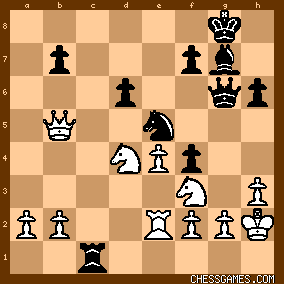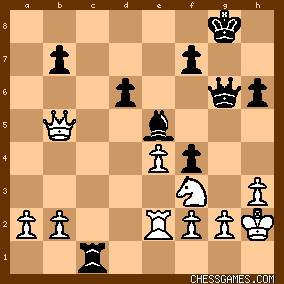|
< Earlier Kibitzing · PAGE 3 OF 3 ·
Later Kibitzing> |
| Oct-08-12 | | Hevelius: It took me a minute as well, but forcing the enemy King to surrender to a victorious pawn is always particularly fascinating... |
|
| Oct-08-12 | | Abulherar: very nice puzzle on monday:{29...Qg3+! 30.fxg3 fxg3#)
this ♕ sac remembers me with the most beautiful ♕ sac
ever played,it was by marshall in 1912. |
|
| Oct-08-12 | | JohnBoy: Black's structure at move 22 is terrible. Only a horrid blunder by white allowed this very cute smothered mate to arise. |
|
| Oct-08-12 | | zb2cr: It took me over a minute to stop examining such moves as 29. ... Qg2+ or a Rook move. Then the actual move finally came to mind. 29. ... Qg3+; 30. fxg3, fxg3#. A nifty little mate. |
|
| Oct-08-12 | | awfulhangover: It's very easy to miss this mate coz it's a mating pattern that is unique and hard to spot with an analogue brain. Took me a minute, not a 5 sec Monday as normal. |
|
| Oct-08-12 | | Gato: Not the greatest Qg3 in the history but really cute (the one I mean does not have the "+"). Anyone for throwing golden coins ? |
|
| Oct-08-12 | | gars: God bless the Mondays! |
|
| Oct-08-12 | | Zatrikion: 29..Qg3+
30.fxg3 fxg3#
Cool! |
|
| Oct-08-12 | | Veryrusty: Go back to move 26; I think White's best is 26. Re1, one of few moves to block the sac-mate threats without (a) having to move the f3 knight and opening up a nasty discovered, or (b) allowing 26. ... Nxf3+, 27. gf, Qg1#. As far as I can tell, Re1 stops everything dead. |
|
| Oct-08-12 | | Marmot PFL: <"Only" 2000 isn't really a terribly weak rating. Experts can play quite well, and often do. It's really more a lack of consistency than a lack of talent that separates them from masters. As for how well Black played, I note that if White had exchanged on e5 rather than play 29. Qd7??, he should have won the ending without too much trouble thanks to his passed pawns on the queenside.> Your 2nd paragraph almost (though not quite) refutes the 1st. 2000 is a good, solid amateur player, but there is a definite talent gap from there to master, and even more to senior master. Most players of average (or slightly better) ability who play and study regularly can eventually make 2000. |
|
| Oct-08-12 | | dufferps: It would appear that Zakaria was anticipating this attack when he moved 28...Qg7. Czajka's 29.Qd7 indicates that he did not see it coming. I guess he thought he could somehow exchange queens, otherwise his move was completely pointless. What would have been the sequence had he advanced his h-pawn to create an escape square? One line:
29. ... Qg6
30. h4 Qg3+
31. fxg3 fxg3+
32. Kh3 h5
33. Nxe5 dxe5
34. Qd5 (and white has the upper hand)
another
29. ... Qg6
30. h4 Qg3+
31. fxg3 fxg3+
32. Kh3 gxf2
33. Rxf2 Rh1+
34. Kg4 f6
35. Qc8+ Kh7
36. Qf5+ (and I see a win for white)
But I doubt that Black would have played that Queen sacrifice after 30.h4.
I just don't know what he would/could have done. |
|
Oct-08-12
 | | chrisowen: Chap python g6 down to g3 glesson slide in piecemeal 29...Qg3+ one point behind f4 as tender dig white has to recapture beet route to his doorkeeper nod in fxg3 head above the parapet in feed him it reign down on me fxg3#. |
|
| Oct-08-12 | | kevin86: Black had a brilliant double play:sacrifice the queen AND mate with a pawn. The only flaw is that he had the same mate TWO MOVES EARLIER. |
|
| Oct-08-12 | | psmith: Not only did Black miss the combo on move 27, she (I am guessing from the name) moved away from the possibility of playing it. I am imaging her thought process immediately after 27... Qh5... "Dang, I had a mate and missed it! But he didn't see it either. I wonder if I set up for it again... maybe he'll miss it again? [crossing fingers]...." But notice this (found with the help of Fritz 5.32):
After 26. Nxe5?? Bxe5, White has no good defense (  )
But 27. Nf3 Qh5?? not only throws away the win, after this White is winning ( )
But 27. Nf3 Qh5?? not only throws away the win, after this White is winning (  ) and it is Black who has no defense. In fact 27... Qg3+ is the only move for Black that does not hand White back a substantial advantage.
After 28. Qxb7 Qg6 White blunders again with 29. Qd7?? and Black doesn't let him out of it again.
But instead 29. Nxe5 wins for White ( ) and it is Black who has no defense. In fact 27... Qg3+ is the only move for Black that does not hand White back a substantial advantage.
After 28. Qxb7 Qg6 White blunders again with 29. Qd7?? and Black doesn't let him out of it again.
But instead 29. Nxe5 wins for White (  ). ).
So this is what Fred Reinfeld would have called a "comedy of errors" (showing my age here). |
|
| Oct-08-12 | | bachbeet: Got it. I think that sometimes the most interesting mates occur when a pawn is the key player. |
|
| Oct-08-12 | | dzechiel: <captainandrewwiggins: something that confuses me: why didn't black play it earlier: 27...Qg3+> I had the same question. The answer must be that he overlooked the mate at that time. |
|
Oct-08-12
 | | FSR: <Infohunter: ... As a matter of fact, you are right, <FSR>. My copy of the Guinness Book, which I received brand new as a Christmas present in 1975, mentions him in the context of having been aced out of first place. I was going to try to dig out my copy of the book to get the exact quote but, upon seeing what a massive project that would be, decided instead to try to quote it as best I can from memory: "The palm for the most determined attempt to be last in the telephone book must now go to Zachary Zzzzra, of San Francisco. He has outdone his nearest rival, who was a mere Zeke Zzzypt of Chicago...."> Very impressive memory! I dimly recall that passage. I knew that poor Zeke got outdone at some point, but hadn't recalled that Zachary Zzzzra was his conqueror. Of course Zeke could have just changed <his> surname to Zzzzra and regained the palm . . . . |
|
| Oct-08-12 | | Nullifidian: 29... ♕g3+ 30. ♙fxg3 ♙fxg3# |
|
| Oct-08-12 | | Patriot: Neat puzzle! 29...Qg3+ 30.fxg3 fxg3# |
|
Oct-08-12
 | | gawain: Mate delivered by a pawn is always fun to see. Even the victim must smile a little, don't you think? |
|
| Oct-08-12 | | Abdel Irada: <Marmot PFL>: <Your 2nd paragraph almost (though not quite) refutes the 1st.> On the contrary: It is the fact that White played well for much of the game, and then unaccountably missed this lethal threat, that speaks of the <inconsistency> to which I referred in my first paragraph. I also note that a great many users here speak disdainfully of experts, but statistics would suggest that most such users are rated under 2000. This reminds me of all the kibitzers who roundly castigate the "stupidity" of grandmasters, thanks to the hard-won wisdom conferred upon the former by the oracles Crafty, Stockfish and Rybka, but who would be hard-pressed to emerge alive from the opening against those "stupid" GMs. |
|
| Oct-08-12 | | TheBish: Z Czajka vs A Zakaria, 1994 Black to play (29...?) "Very Easy"
Bookmarking this so I can print out for my students. (I often skip Mondays.) 29...Qg3+! 30. fxg3 fxg3#. |
|
| Oct-08-12 | | TheBish: Funny that Black missed this two moves earlier. Lucky to get another chance! |
|
| Oct-09-12 | | Once: <al wazir: So, why didn't black play 27...Qg3 ?> I think you deserve a better answer than you've had up to now. So let me try ... This is the position just before both players missed the Qg3+ mate. 
click for larger viewIt's white to play.
He looks to be pretty safe. The focal point for the black attack seems to be g2, but white can't aim another piece at that square. White seems to have made a fortress on the kingside, which means that he is free to hoover pawns on the queenside. Neither white nor black have a sense of danger at this point because the Qg3+ combination doesn't work yet. What is more, g3 seems a very unlikely entry square for the queen because it is well guarded. Black just doesn't have enough pieces in the attack. Let's call it defcon 4. Now white decides to trade off a pair of pieces - standard practice when up in material. So he plays the disastrous 26. Nxe5. He doesn't see that this drags the black bishop to e5, which means that Qg3+ becomes playable. This is the position that black finds himself in a couple of moves later ... 
click for larger viewThe dynamics have changed, but it was white who changed them and not black. White pulled the black Bg7 onto the e5 square. That means that black hasn't fully analysed the consequences of that change - because he didn't choose to make it. It is much easier to see a combination if you have analysed it and prepared it. It is much harder if your opponent plays the first part of the combination for you. In the POTD, we get none of this. When we first analyse, we don't see the moves before the puzzle. We don't get the benefit of being part of a sustained attack. But equally we don't get the disbenefit of looking in the wrong place when the dynamics of the situation suddenly changes. So to answer your question, black didn't play 27...Qg3 because he didn't see it. And I think the reason he didn't see it was because it had only just become possible, and only because of a faulty plan by his opponent. |
|
| Oct-16-12 | | The Last Straw: White's only way to stop any mate after 26...♗xe5 is 27.♕e8+ followed by 28.♕xe5. |
|
 |
 |
|
< Earlier Kibitzing · PAGE 3 OF 3 ·
Later Kibitzing> |





